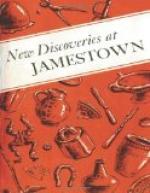In the small houses at Jamestown the kitchen also served as the dining room. During the early years, many settlers probably ate with wooden spoons out of wooden bowls and trenchers, and drank from mugs made of horn, wood, or leather. As the colony became well established, these crude utensils and vessels were used less frequently and were gradually replaced with ones made of pottery, metalware, and glassware. None of the perishable woodenware, horn, or leather items have been found at Jamestown, but a large assortment of more durable objects used at the table have been recovered. Space permits only brief descriptions of the more common types unearthed.
KNIVES, FORKS, AND SPOONS
The table knives found at Jamestown vary in length from 6-3/8 to 8-1/4 inches. Most of them have either bone or ivory handles, although 3 have embossed brass handles; and 1, found in a late 17th-century well, has an exquisite handle of banded agate.
The forks in the collection also have bone or ivory handles, the majority displaying 2 steel prongs, or tines. The number of prongs, however, is no positive identification of any particular period, as many English forks of the mid-17th century had 3 prongs, and a few had 4 prongs.
Types of spoons excavated include seal-heads, slipped ends, “puritans,” and trifids. The majority were made of either pewter or latten metal (a brasslike alloy), although 3 in the collection were made of silver. The earliest spoons found have rounded bowls and 6-sided stems (handles), whereas those made after 1650 usually have oval bowls and flat, 4-sided handles. One of the silver spoons, with rounded bowl and slipped end, bears the initials of its owner, “WC/E,” on the slipped end of the handle. This spoon appears to have been made between 1600 and 1625, and is still in excellent condition.
The most important spoon in the Jamestown collection, and one of the most significant objects excavated, is an incomplete pewter spoon—a variant of the trifid, or split-end, type common during the 1650-90 period. Impressed on the handle (in the trefoil finial of the stem) is the mark of the maker, giving his name, the Virginia town where he worked, and the year he started business. This is the sole surviving “touch” or mark of an American pewterer of the 17th century. The complete legend, encircling a heart, reads: “IOSEPH Copeland/1675/Chuckatuck.” (Chuckatuck is a small Virginia village in Nansemond County, about 30 miles southeast of Jamestown.) Joseph Copeland later moved to Jamestown where he was caretaker of the statehouse from 1688-91. He may have made pewter in Virginia’s first capital. His matchless spoon found in the old Jamestown soil is the oldest dated piece of American-made pewter in existence.




